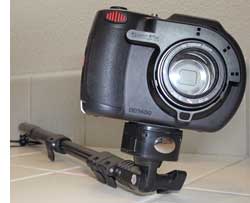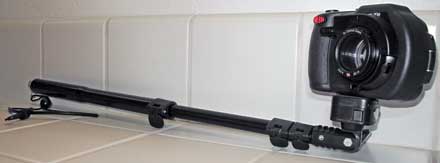First off; I need to say that I have been waiting for this product. Ever since I got my hands on a GoPro, I have been looking for ways to get the camera close to my subjects while keeping my distance.
Most marine creatures are not real concerned about a little camera that is smaller than a bar of soap. However, that completely changes when it comes with a hand, and arm and a bubbling swimming goggle-eyed diver. The wide angle lens on the GoPro demands most subjects be close, and reducing the amount of water between the subject and the camera reduces the amount of light-diffusing particles.
Underwater videography happens best up close. A critical issue for the responsible diver to consider, is that in our excitement to record a cool species we are coming dangerously close to the reef, risking knocking off or damaging corals and other creatures. Everyone has cringed watching the new diver with a camera crash the reef in his quest to grab a shot. Additionally, some marine animals, such as lionfish, morays, and sharks, pose a genuine risk to the videographer who gets too close.

The SeaLife AquaPod is a four section collapsible black anodized aluminum pole with a tilt-able camera mount on one end and a smooth black rubber grip and removable lanyard on the other. It extends from 18 inches to 53 inches. Each section has a thumb tab flick lock.  The quick release camera mount fits SeaLife cameras and any camera with a standard 1/4-20 tripod mount. The camera mount has a little wide angle mirror on it for framing self-portraits. The connection between the camera mount and the extendable pole is secured with a thumb screw that allows loosening and tilting the head. Throughout the rang of tilt, there are detent every five degrees or so. While the AquaPod is a SeaLife product, an adapter to mount any GoPro camera is included.
The quick release camera mount fits SeaLife cameras and any camera with a standard 1/4-20 tripod mount. The camera mount has a little wide angle mirror on it for framing self-portraits. The connection between the camera mount and the extendable pole is secured with a thumb screw that allows loosening and tilting the head. Throughout the rang of tilt, there are detent every five degrees or so. While the AquaPod is a SeaLife product, an adapter to mount any GoPro camera is included.
What it amounts to is that the SeaLife Aquapod provides the diver with about a four foot extension of his or her reach with a camera. It greatly increases the ability to get close to the subject with light cameras with wide angle lenses. This allows the camera to get close in to marine creatures with less risk of stressing and startling them. The capacity to stand back from the reef minimizes the risk the videographer will head butt a brain coral or surgically remove a gorgonian with his fin. This may also provide a measure of safety when dealing with aggressive or venomous animals.
The first impression when you pick up the AquaPod is that it is light, well made, and easy to handle. Twenty dives later, this impression had not changed. Mounting a camera is easy.
For a camera with a standard tripod mount, you merely screw (is this slotted?) the detached quick-release plate to the camera, then slide the plate into place. The mount has a secure latch that is released with the push of a button. I never had any issues with accidental release.
For a GoPro camera, a dedicated quick release plate connects directly to the two tabs on the bottom of the GoPro housing, just like every other GoPro mounting accessory.
With camera mounted, you can set the tilt on the AquaPod head to point the camera where you want it to point. The tilt has secure detents, and would be pretty unlikely to move once set. There is a light weight lanyard with a slide lock to cinch it to your wrist and a light duty clip to attach it to your BC. Neither the lanyard nor the clip is particularly rugged. The clip does not inspire trust, and is pretty much useless as it is too small to actually clip to a standard D-ring. Attaching a legitimate retractor would be my first (and probably only) modification to the AquaPod.
The four thumb tabs for locking and unlocking the sections are easy to use, tucked together so all of them can be released at once, and lock easily and securely. To extend the Aquapod, all you need to do is open all the thumb tabs, shake out the sections, and then lock each of them. It only takes a couple of seconds, and is not fussy like many tripod section locks. The smooth operation is very impressive. Each section tube has a groove that accepts a spline from the tube inside it. This keeps the section tubes from rotating when unlocked. This is a nice touch that makes the AquaPod easier to handle.
Fully extended, the ApuaPod is surprisingly stable and easy to handle. On the no-current dives we did during our stay at CocoView Resort on Roatan, I was able to hold the camera steady with one hand, though two is always better. I had initially thought I would want some sort of a second handle to keep the setup stable, but the large handle and light weight kept stability from being an issue, even when swimming.

SeaLife suggests that the AquaPod can be used for photo or video. It is hard for me to imagine how this item could benefit single-shot still photography, as when it is extended you would have to reach to the camera to trip the shutter. I guess you could self-timer, but this would have limited utility. On the other hand, if you set the GoPro to continuous photo mode where it takes a pic every so many seconds, you could end up with great close-up shots.
Once I put a camera on the AquaPod, I did not want to take it off. I was able to get video that would have been far more dangerous to me or the reef with a hand mount. The stability did not match a tray with two handles, but it came pretty close.
Best of all, the AquaPod opened up new creative opportunities for me. I have always been fascinated by the mobs of tangs that roll over the reef. With the AquaPod, I was able to stick a camera right down into the mob, and then move along with them. I was also able to get a camera in close to a pair of Spotted Drums, then set the AquaPod down in the sand and move away.
All in all, the SeaLife AquaPod (suggested retail price US$69.95) provides a credible mounting option for the underwater videographer who wants to unobtrusively close the distance between them self and their subject.
Go to the SeaLife AquaPod webpage.










